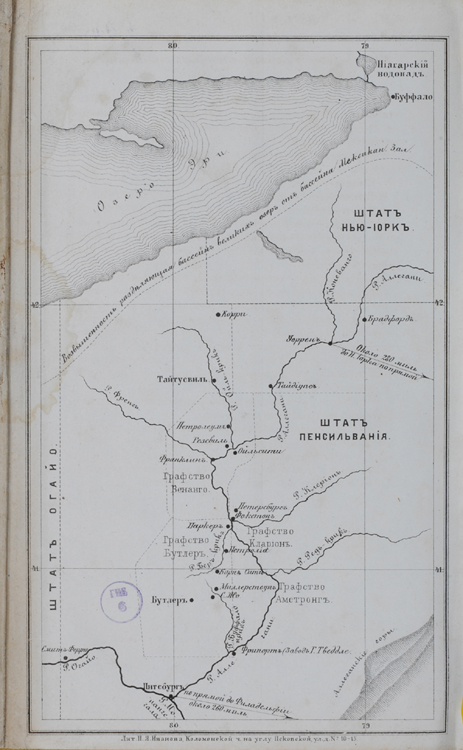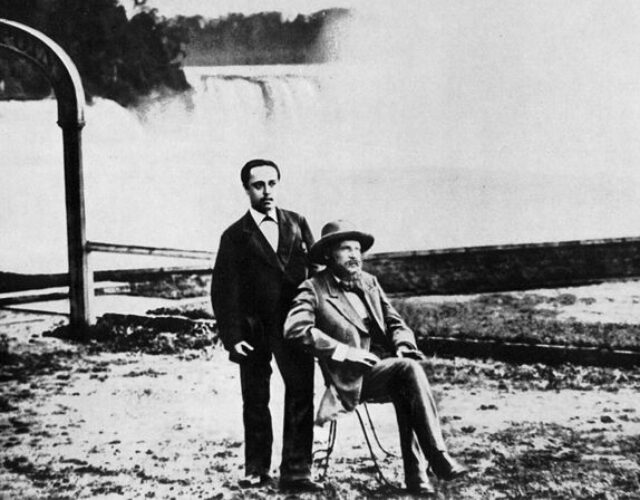Long before international relations between the United States and Russia centered on allegations of election tampering and controversial business deals, they focused briefly on Dmitri Mendeleev. National Periodic Table Day on February 7 celebrates Mendeleev’s birthday and his “periodic law,” in which he arranged the more than 60 elements known at the time into a single table based on their atomic weights, correctly predicting the properties of numerous additional elements and their compounds. As the 33-year-old chair of chemistry at the University of St. Petersburg, Mendeleev began working on this periodic law while writing a textbook in 1867, publishing it initially as a series of papers in 1869 and then as Osnovy khimii (Principles of Chemistry) in 1871. So what then did the father of the periodic table have to do with U.S.-Russian relations?
In 1876 Mendeleev traveled to Pennsylvania on behalf of the Russian government. He stopped in Philadelphia, where he attended the International Exhibition of Arts, Manufactures, and Products of the Soil and Mine, more commonly known as the Centennial Exposition, which drew approximately 10 million visitors to Fairmount Park. He joined a group of Russian scientists and engineers who exhibited items on everything from mining and metallurgy, to agriculture, to meteorology. Mendeleev’s scientific pursuits were equally far reaching. He had advised Russia’s Ministry of Finance on several domestic issues, such as alcohol tariffs, gunpowder, and agricultural reform. And as Michael Gordin noted in his biography A Well-Ordered Thing: Dmitrii Mendeleev and the Shadow of the Periodic Table, Mendeleev attended the Centennial Exposition to showcase a differential barometer he developed after studying gases at varying temperatures. Yet the primary reason for Mendeleev’s visit to America was oil.
According to Ronald Brashear, who oversees the Othmer Library, “A large part of Mendeleev’s interest was in encouraging better production and refining in Russia.” In 1859 Edwin Drake struck oil in Titusville, Pennsylvania, drilling the first commercial oil well. Oil fields in Pennsylvania consisted of light crude much easier to refine than the heavier crude available in Russia, where the petroleum industry centered on the region near Baku, a city on the Caspian Sea and the modern-day capital of Azerbaijan. But Baku’s oil deposits, discovered in the early 1800s, remained under the control of the Russian state and were largely undeveloped. As a result American kerosene inundated Russian markets.
In “Baku Oil and Transcaucasian Pipelines, 1883–1891: A Study in Tsarist Economic Policy,” John McKay contends that despite a high Russian tariff, America was supplying a whopping 80% to 90% of Russian kerosene by the 1870s. And the vast majority of that oil was being refined by John D. Rockefeller’s Ohio-based Standard Oil Company, which controlled oil production in western Pennsylvania by the time of Mendeleev’s visit.
Mendeleev’s interests in American oil were more economic than scientific. He wanted Russia to compete with American imports and supply kerosene to its own central population. As Brashear explained, Mendeleev traveled to the western part of Pennsylvania to “visit refineries, interview people involved in the local oil industry, and study rock formations in the area.” A rare 1877 work from the Roy G. Neville Collection titled Neftianaia promyshlennost v svievero-amerikanskom shtatie Pensil’vanii i na Kavkaze (The Oil Industry in the North American State of Pennsylvania and the Caucasus) documents Mendeleev’s journey to the so-called Petroleum Valley. Though the work has yet to be translated, it contains a map of western Pennsylvania, in which Mendeleev meticulously marked in Cyrillic letters the bodies of water (Lake Erie, Allegheny River), cities (Titusville, Pittsburgh), neighboring states (Ohio, New York), and most important, oil production centers throughout the region.

At the time of his visit to western Pennsylvania, Mendeleev wasn’t well known outside Russia. Although he presented his periodic law to the Russian Chemical Society in 1869, he continued to fine-tune his periodic table in many editions of The Principles of Chemistry; while the book was published in several parts, the second volume, published in 1871, included a fold-out chart resembling a modern-day periodic table. Mendeleev only gained broader recognition within the international scientific community after the discoveries of new elements within his lifetime—including gallium, scandium, and germanium—literally filled the gaps of his periodic table and proved his predictions about the patterns between groups of elements. He subsequently presented his research in London in 1889, called “The Periodic Law of the Chemical Elements.”
Mendeleev returned from the United States to Russia with enough information to profoundly affect Russia’s nascent oil industry. Based in part on Mendeleev’s recommendations, the Russian government opened the floodgates of the oil industry, essentially turning over Baku’s petroleum deposits to private entrepreneurs who began using American drilling techniques. Of those, perhaps the most successful were Ludwig and Robert Nobel (brothers of Alfred Nobel, founder of the eponymous prizes), all of whom grew up in St. Petersburg where their father had a mechanical engineering company. The Nobel Brothers Petroleum Company dominated the industry by the late 1870s, building pipelines and developing the first oil tankers to ship across the Caspian Sea.
By 1883 Russian oil production had increased over 20 times in a 12-year span, and roughly half of Russian kerosene shipments were coming from the Nobel Brothers’ company. As McKay notes, by 1900 Russian oil “accounted for fully one-half of the world’s production of crude oil.” Yet while Mendeleev witnessed the realization of his vision for Russia to harness its own petroleum, he became heavily critical of the overproduction that was occurring.
He published a series of papers in 1881 called “Where Should the Oil Refineries Be Built?” in which he condemned Russia’s oil industry for blindly following American production techniques, since only 25% to 30% of Baku crude could be refined into kerosene, unlike American crude. This led to a massive amount of waste from the leftover oil that was burned or dumped into the Caspian Sea. “This waste appalled Mendeleev and other technical experts,” McKay concludes.
Mendeleev went from wanting Russian oil to be shipped to central Russia to proposing the relocation of Russian refineries to the country’s interior. Such suggestions drew criticism from his scientific peers and Ludwig Nobel alike. Nevertheless Mendeleev would continue to devote a significant portion of his remaining years to advocating for further innovations to Russian oil production, from improvements to oil quality to the creation of a pipeline stretching through the Caucasus to the Black Sea.




